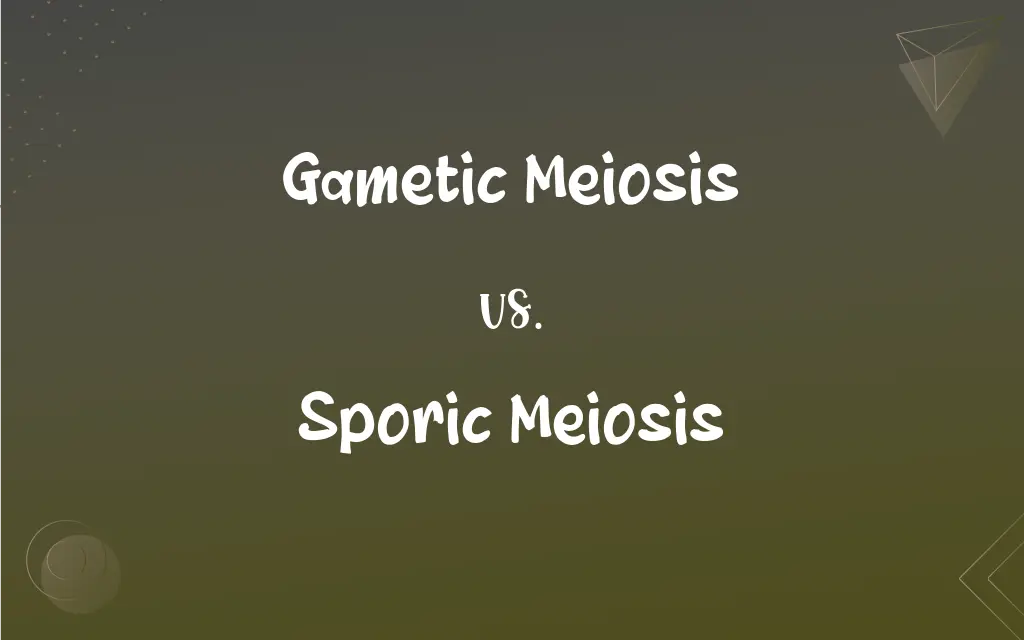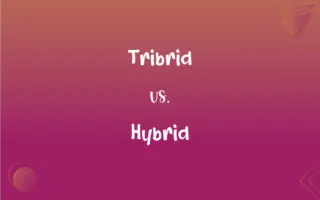Gametic Meiosis vs. Sporic Meiosis: What's the Difference?
Edited by Janet White || By Harlon Moss || Updated on October 30, 2023
Zygotic meiosis is a form of meiosis where the zygote directly undergoes meiosis to form haploid cells; Sporic meiosis involves a multicellular diploid phase before meiosis.

Key Differences
Zygotic meiosis and sporic meiosis represent two distinct life cycles in organisms. Zygotic meiosis is characteristic of haplontic life cycles, where the zygote, the only diploid stage, immediately undergoes meiosis to produce haploid cells that grow into the adult organism. In contrast, sporic meiosis is a feature of diplontic and haplodiplontic life cycles, where the zygote grows into a multicellular diploid organism, and meiosis occurs in specialized cells to produce spores that then grow into the adult.
In zygotic meiosis, the process of meiosis occurs right after the formation of the zygote, leading to the production of haploid cells. In contrast, sporic meiosis involves a multicellular diploid phase called the sporophyte, which undergoes meiosis to produce haploid spores. These two processes represent fundamental differences in the life cycles of various organisms, with zygotic meiosis being characteristic of some algae and fungi, and sporic meiosis being typical of plants and some algae.
Zygotic meiosis is a process that ensures genetic diversity in populations by reshuffling genetic material during the formation of gametes. Similarly, sporic meiosis also contributes to genetic diversity, but it does so in a different way. In sporic meiosis, the multicellular diploid phase allows for additional opportunities for genetic recombination before the production of spores.
Zygotic meiosis and sporic meiosis both play crucial roles in the life cycles of various organisms. Zygotic meiosis is a key feature of haplontic life cycles, where the adult organism is haploid and the zygote is the only diploid stage. In contrast, sporic meiosis is a feature of diplontic and haplodiplontic life cycles, where the adult organism is diploid and meiosis occurs in specialized cells to produce haploid spores.
Comparison Chart
Life Cycle
Haplontic
Diplontic or Haplodiplontic
ADVERTISEMENT
Diploid Stage
Zygote only
Multicellular sporophyte
Haploid Stage
Adult organism
Produced spores
Genetic Diversity
Through meiosis in zygote
Through meiosis in sporophyte
Example Organisms
Some algae and fungi
Plants and some algae
Gametic Meiosis and Sporic Meiosis Definitions
Gametic Meiosis
Zygotic meiosis is a process that occurs in specific groups of organisms.
Zygotic meiosis is a key feature of the life cycles of some types of algae.
ADVERTISEMENT
Sporic Meiosis
Sporic meiosis is characteristic of diplontic and haplodiplontic life cycles.
Sporic meiosis contributes to genetic diversity in plant populations.
Gametic Meiosis
Zygotic meiosis is characteristic of haplontic life cycles.
Zygotic meiosis ensures genetic diversity in haplontic life cycles.
Sporic Meiosis
Sporic meiosis is a process that occurs in specific groups of organisms.
Some species of algae exhibit sporic meiosis as part of their life cycle.
Gametic Meiosis
Zygotic meiosis is a form of meiosis that occurs right after fertilization.
Some fungi exhibit zygotic meiosis as part of their life cycle.
Sporic Meiosis
Sporic meiosis is a form of meiosis that involves a multicellular diploid phase.
In plants, sporic meiosis leads to the production of haploid spores.
Gametic Meiosis
Zygotic meiosis is the process where the zygote undergoes meiosis.
In some species of algae, zygotic meiosis leads to the formation of haploid cells.
Sporic Meiosis
Sporic meiosis involves the division of specialized cells in the sporophyte.
Sporic meiosis results in the formation of haploid cells that can grow into new individuals.
Gametic Meiosis
Zygotic meiosis involves the direct division of the zygote into haploid cells.
Zygotic meiosis results in the production of genetically diverse offspring.
Sporic Meiosis
Sporic meiosis is a form of meiosis that occurs in plants and some algae.
Sporic meiosis is a crucial process in the life cycle of ferns.
FAQs
What are the key differences between zygotic and sporic meiosis?
Zygotic meiosis involves direct division of the zygote, while sporic meiosis involves a multicellular diploid phase.
Which organisms typically exhibit zygotic meiosis?
Zygotic meiosis is typical of some algae and fungi.
What is zygotic meiosis?
Zygotic meiosis is a form of meiosis where the zygote directly undergoes meiosis to produce haploid cells.
What is sporic meiosis?
Sporic meiosis is a form of meiosis involving a multicellular diploid phase that undergoes meiosis to produce spores.
How does zygotic meiosis contribute to genetic diversity?
Zygotic meiosis reshuffles genetic material during the formation of gametes.
Can sporic meiosis occur in fungi?
Sporic meiosis is not typically found in fungi.
Can zygotic meiosis result in the production of multicellular haploid organisms?
Yes, the haploid cells produced by zygotic meiosis can grow into multicellular haploid organisms.
What is the significance of the diploid phase in sporic meiosis?
The diploid phase allows for additional opportunities for genetic recombination.
Is zygotic meiosis always associated with haplontic life cycles?
Yes, zygotic meiosis is characteristic of haplontic life cycles.
What is the haploid phase called in organisms that exhibit zygotic meiosis?
The haploid phase is called the gametophyte.
What is the role of meiosis in zygotic meiosis?
Meiosis in zygotic meiosis ensures genetic diversity by reshuffling genetic material.
How does sporic meiosis contribute to genetic diversity?
Sporic meiosis allows for genetic recombination in the multicellular diploid phase.
Can sporic meiosis result in the production of multicellular haploid organisms?
Yes, the spores produced by sporic meiosis can grow into multicellular haploid organisms.
What is the haploid phase called in organisms that exhibit sporic meiosis?
The haploid phase is called the gametophyte.
Are there any exceptions to the typical organisms that exhibit zygotic or sporic meiosis?
There may be some exceptions, but in general, zygotic meiosis is found in some algae and fungi, and sporic meiosis is found in plants and some algae.
Are there organisms that exhibit both zygotic and sporic meiosis?
No, organisms typically exhibit one form of meiosis or the other.
Which organisms typically exhibit sporic meiosis?
Sporic meiosis is typical of plants and some algae.
Can zygotic meiosis occur in plants?
Zygotic meiosis is not typically found in plants.
What is the role of meiosis in sporic meiosis?
Meiosis in sporic meiosis ensures genetic diversity by reshuffling genetic material in the diploid phase.
Is sporic meiosis always associated with diplontic or haplodiplontic life cycles?
Yes, sporic meiosis is characteristic of diplontic and haplodiplontic life cycles.
About Author
Written by
Harlon MossHarlon is a seasoned quality moderator and accomplished content writer for Difference Wiki. An alumnus of the prestigious University of California, he earned his degree in Computer Science. Leveraging his academic background, Harlon brings a meticulous and informed perspective to his work, ensuring content accuracy and excellence.
Edited by
Janet WhiteJanet White has been an esteemed writer and blogger for Difference Wiki. Holding a Master's degree in Science and Medical Journalism from the prestigious Boston University, she has consistently demonstrated her expertise and passion for her field. When she's not immersed in her work, Janet relishes her time exercising, delving into a good book, and cherishing moments with friends and family.































































